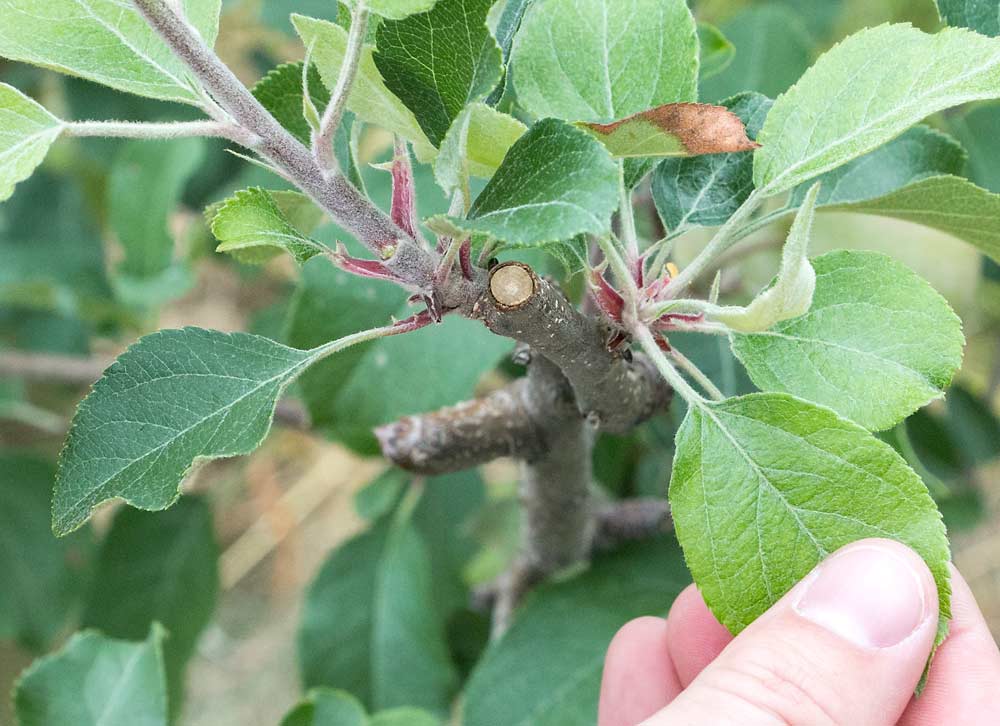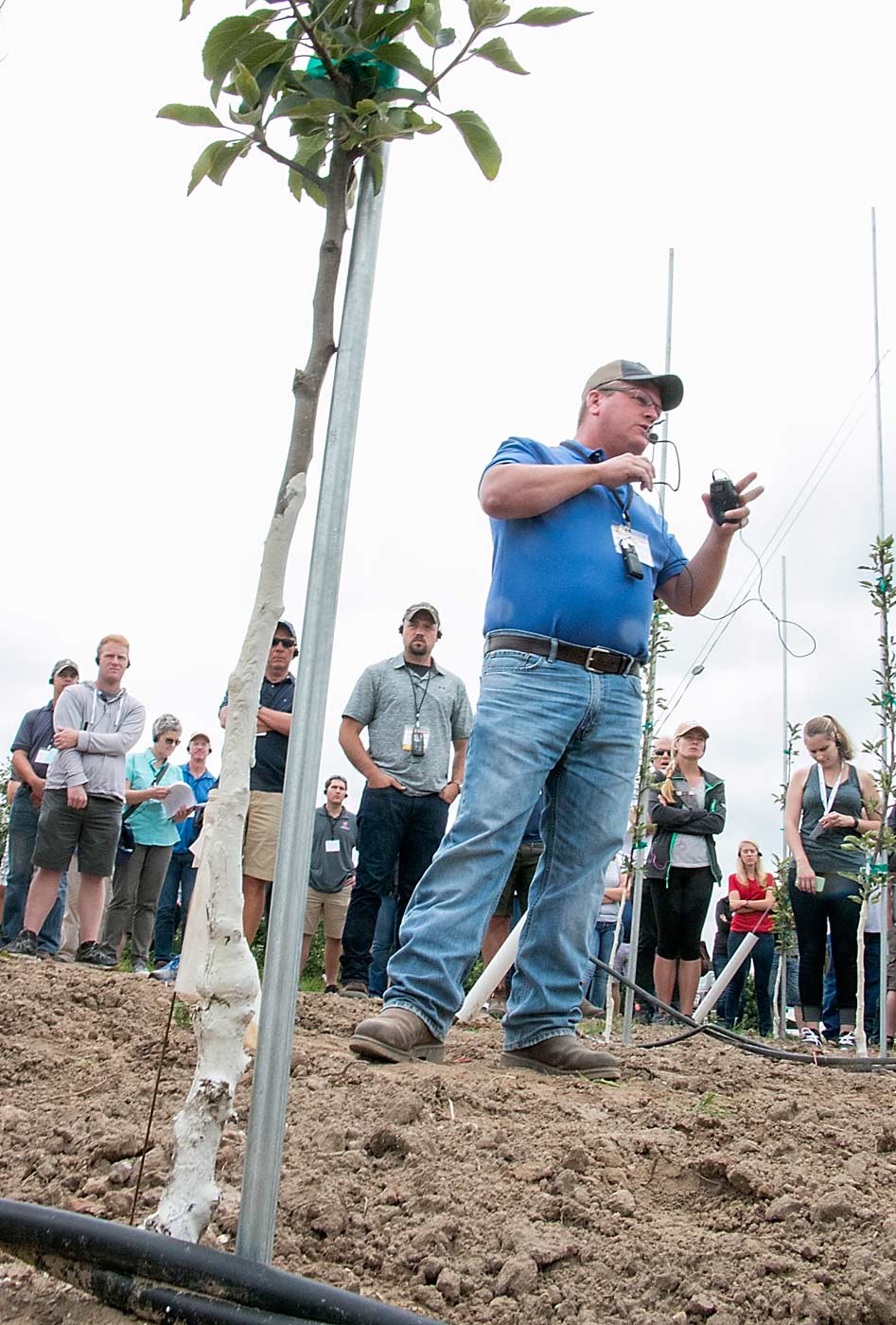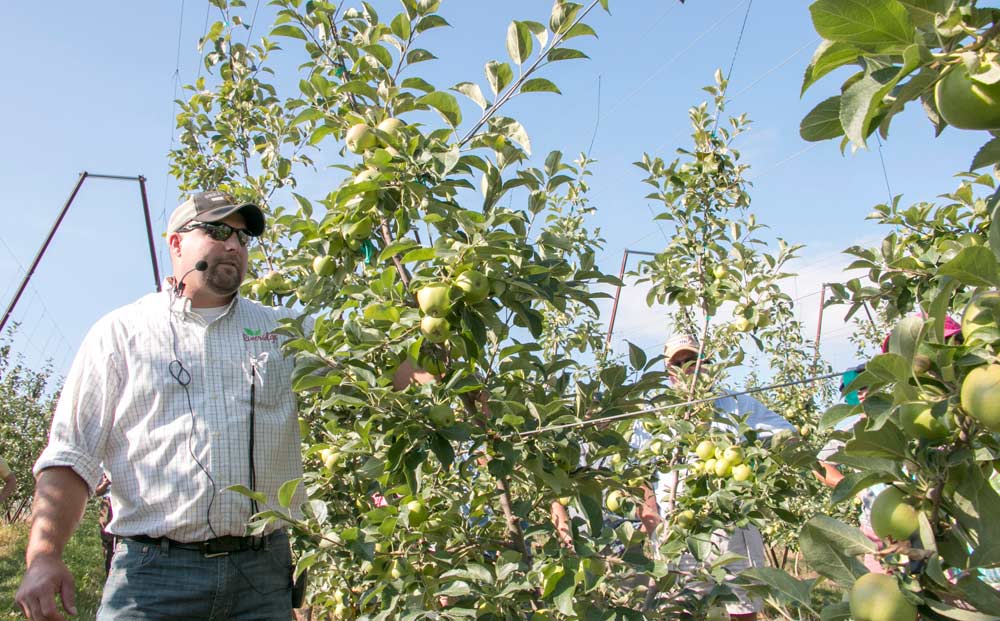
Participants at the International Fruit Tree Association’s Summer Tour in July walk by a planar cordon multi-leader training system of Royal Red Honeycrisps at Tom Rasch & Son Orchard in Belding, Michigan. A key topic on the tour near Grand Rapids: training young, high-density orchards.
(Ross Courtney/Good Fruit Grower)
The increasing number of Michigan growers rapidly transitioning to modern, high-density orchards for the fresh market has resulted in a state with a lot of young orchards.
Everywhere, immature trees reach for the tops of trellis wires. More new plots are on the way.
“They’ve got trees ordered out two or three or four years out into the future,” said Phil Schwallier, a Michigan State University extension horticulturist in Sparta.
Those young trees must be planted, trained and pruned in an orchard architecture that will maximize fruit quality and performance.
That’s why training systems in the first three years was a major topic of the International Fruit Tree Association’s summer tour in July, held in Michigan’s fruit growing region just north of Grand Rapids.
The area, dubbed The Ridge for its modest rise in topography, is home to the bulk of Michigan apples, about 60 percent of which are now grown for the fresh market after decades of primarily feeding processors.
There are no solid rules for crafting Michigan’s rapidly evolving systems, Schwallier said. “Everybody has their own menu or recipe for what they do.”

A mechanical hedge cut on a fifth-leaf Aztec Fuji branch is shown on a tour stop at Tom Rasch & Sons in Belding. The Rasches use hedging at green tip on young trees to control vigor in the canopy and push vigor to the tops of leaders. (Ross Courtney/Good Fruit Grower)
But usually the main goal is to coax the tops of the tree to their final height, usually the top wire of a trellis system at 9 or 10 feet, before growers start cropping.
Many varieties stop growing as soon as they start bearing fruit. Honeycrisp, the most popular new variety in Michigan, is notorious for that.
Growers typically use trellises with vertical stakes of conduit or bamboo, vertical lengths of twine or just the horizontal trellis wires. The most common spacing is 2 feet between trees with 10- to 12-foot rows.
Multiple leaders
Some growers are trying multiple leaders, hoping they can fill their orchard row space with fewer trees.
Kyle Rasch, a third-generation grower in Belding, has several double rows and more traditional orchard designs, but he has his own informal trial block of multiple leaders ranging from two to 12 leaders.

Chris Kropf, a grower in Greenville, trains young trees, including these first-year Gale Galas, with metal conduit instead of bamboo even though its more expensive because he likes the rigidity. (Ross Courtney/Good Fruit Grower)
Some of them are planted on planar cordon systems, which involves starting the trunk at an angle, bending it horizontally and training branches to grow vertically. It’s similar to the upright fruiting offshoot (UFO) system for sweet cherry trees.
Rasch likes what he sees so far and has noticed the tighter he spaces the leaders, the more they compete with each other to fill their vertical space. He considers 1.5 feet between each ideal. To even out the growth, he plans to fruit the leaders that have reached their tops and stripping the leaders that have not to encourage them to grow.
“I’m not sure if I’m going to implement it or not, but I’m definitely interested in the way these multi-leaders fill in their space,” he said.
Bill Nyblad of New Leaf Orchards of Kent City was one of the first in the state to train with multiple leaders. He advocates using hand-held hedge cutters, or shears, as a way to control vigor in the first few years in his 2-foot spacing trees.
Around the summer solstice — a little later if he wants to avoid regrowth — he sends his crews with hedge cutters to snip away branches longer than 6 to 8 inches to push the leader upward and encourage fruiting surfaces closer to the trunk.
His long-term goal: to create an environment for mechanical hedging and picking with either platforms or a robotic picker.
The technique is fast, cheap and doesn’t require much training. “They’re about $12 from Menards if you buy them on the right day with a rebate,” he said with a laugh.
Nyblad also uses hedge cutters for summer pruning on mature trees to control fruit size and bitter pit, improve light interception and keep his canopy tight.
To crop or not to crop?
Chris Kropf, owner of Hart Fruit Farm in Greenville, showed tour attendees first-, second- and third-leaf orchards. He described aggressive methods such as intense pruning and heavy nitrogen treatments for pushing the trees to reach the top leader and not trying to crop until they do.
“We want to be able to fill this canopy properly and as fast as possible before we get too greedy in cropping,” he said.
In contrast, he pointed out a block of Honeycrisp, about 7 years old, he believes he cropped too soon and “paid the price.”
They just didn’t grow as tall.
Most of his new blocks were grafted on Budagovsky 9, a precocious rootstock that takes extra work to grow to the top.
So far, Kropf has been whipping the limbs back to 2 to 4 inches from the trunk each of the first three years to push the growth upward, leaving the trees at their height at the time of delivery. That forces multiple breaks, which he thins out to leave only the thinnest, flattest branches.
He is questioning himself now, though. He may in the future decide to leave the trees alone the first year to give them time to get over the transplant shock and begin whipping, as well as cutting back the tops to 18 inches above the highest branch, in year two.

Justin Finkler, a grower for Riveridge Land Co. in Grant, points out the details of a training system on a 2014 V-trellis block of Honeycrisp. He decided to crop apples in the bottom portion of the trees this year to control lower-tree vigor, but stripped the flowers in the top part to encourage leader growth. (Ross Courtney/Good Fruit Grower)
Also, in spite of his warnings about cropping too early, Kropf left a crop of apples on the bottom part of the canopy to slow down the growth in that area on his third-year Evercrisp trees.
One of the largest fruit companies in Western Michigan is doing the same thing. Riveridge Land Co. has 220 acres of newly planted apples, compared with 520 acres already in production with locations in Sparta and Grant.
At the time of the tour, ripening apples hung on the lowest three wires of the company’s seven-wire V-trellised Honeycrisp block. The top four were bare, stripped of their flowers at bloom.
“With these apples here, we’re trying to control the size by leaving this many on here,” said Justin Finkler, operations manager, leading a tour through the block, planted on M.9 Nic 29 rootstocks in 2014. The company hand thinned more in August to hit the target fruit size, Finkler said.
That’s not a universal idea, said Schwallier, also a Michigan orchard owner and an IFTA board member. Some growers believe all fruit must come off while getting young trees into shape. But he expects differing opinions as Michigan growers shift to modern orchards.
“This is basically how a lot of change takes place,” he said. •
– by Ross Courtney






Leave A Comment